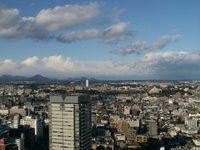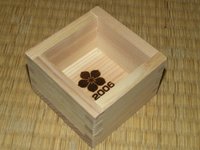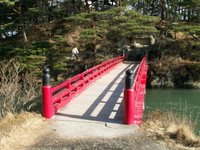On the 28th December I met Keiko in Tokyo station and boarded a Shinkansen bound for Sendai. There was so much I was uncertain about – meeting her parents who spoke no English, what I would be doing over the next few days, how Japanese families spend New Year, when I would be returning home – that it was almost too overwhelming not to worry about. I’ve been in so many alien situations this year that I’ve realised it’s better to not think about it and just see what happens.
With everyone returning home for the holidays, the 28th actually turned out to be the busiest day, with 130% ticket sales. Luckily, we found two seats, and after travelling 304km in under two hours, we arrived. Although Tokyo’s temperature had dropped, it still had that city trapped warmth that seems to happen in high density places. Sendai, on the other hand, was freezing being North-East of Tokyo.
Sendai has a population of one million, although spread out over a large area, so that it is vastly different in feel to Tokyo. People there lived in detached houses! It is also home to many delicacies; many of which I tried. The first was 牛タン (gyuu-tan) or cow tongue. In the station is a famous ‘road’ of these restaurants, serving strips or beef with dark sauce. It was Ok, but I wouldn’t rush to eat it again.
Leaving the station, we ascended a huge tower to see the view – it was clear that Sendai was quite well planned out – and much more grid-like than Tokyo. The centre is formed around three main shopping streets, with the outskirts being suburban in the same manner as Britain. However, the surroundings act as a natural barrier – with the sea on one side and mountains encasing the city the rest of the way around.


Keiko’s house is about 20 minutes outside Sendai city, so we took a city train (the most expensive in Japan) and her Mum picked us up from their local station. Tokyo’s train structure is incredible, and without it, daily living would be impossible. However, this was more like Bournemouth – a car is a near must. It was also at this point that I realised I hadn’t been in a car in Japan up until now (except for a few taxis).
At her house, I was officially welcomed by Keiko’s mum and their dog, Taffy – the craziest animal I’ve ever met. A peculiar problem arrived – what did I call her parents? In England, their first name or Mr___/Mrs___ are both acceptable. Here, Terui-San could mean any of the three, and they don’t feel so comfortable using their own first names; although they called me フィルさん (Phil-San).

The answer is that you call other peoples’ parents お父さん・お母さん (otousan/okaasan) – literally, ‘Father’ or ‘Mother’. This is culturally accepted in Japan, but made me, and I’m sure many of you, a little uncomfortable in terms of sounding much closer by name than by kinship. Eye contact seemed like my best option.
We didn’t do much that afternoon, as we were both tired from NOVA and the train, but we took Taffy for a walk. Sadly, there is a big market in Japan to dress pets up, and Taffy had his fair share of outfits.




The house was quite high up, and had a good view of the city centre as well as the mountains, some of which looked quite snowy already. Snow was predicted that week although the main skiing season begins in February.




‘Father’ returned home from his last day at work a little drunk. It’s customary to go drinking with your boss at the end of the year, even if you don’t want to.
I had already gained so many insights into Japanese life in such a short time, and realised this really was a great chance for a ‘homestay’, which I advise all my students to go and do. I’d taken my own advice without even knowing it!
We ate sushi for dinner, including some new fish. One, awabi - edible but I wouldn’t eat it out of choice - is famous for looking like a “lady’s tuppence”. It was cut up by this point, so I didn’t have a chance to find out first hand, but this picture seems to do the trick:

We ate so much, and drunk a lot of hot sake, which I’d never tried before. It was much better than when served cold. We also drunk it out these wooden ‘cups’ - a lot easier to drink from than it looks - which are typically presented to staff by their company at the end of the year. I never found out the meaning behind it, so if anyone wants to do some homework, maybe try wikipedia.

Although Takao (‘Father’) tried his best with English, which wasn’t bad, the Mother spoke extremely little for Japanese standards – another difference between Sendai and Tokyo: even if you don’t learn English there’s so much around the capital in adverts/programmes/shops that you pick up a lot anyway compared to smaller cities – that I had to use a lot of the Japanese I picked up with Keiko translating most of the conversation. This was difficult but I found I had enough to keep me going, for example – talking about when I came to Japan, past experiences, family and so on. It was great practice as a teacher as it showed which topics, phrases and vocabulary are actually useful in real situations. And, although still terrible, my Japanese improved dramatically.
It was also funny because, any other situation it’d be rude to almost ignore your friend’s parents or give one word answers, but here it became the norm for people to laugh at a joke, have it translated and then for someone else to laugh. There was a lot of smiling and patience involved, but it wasn’t half as uncomfortable as I expected it can be.
One more difference – the Japanese family is very old-fashioned in terms of each family member’s role and duties. Mrs Terui was definitely treated as cook and cleaner. It took me a while to get my head around the way she was spoken to and how pleasantly she replied, but that was the way Keiko explained things work, and that there wasn’t much animosity about it. She didn’t eat dinner, and Keiko said this was for dietary reasons, but I have a feeling that with all the to-ing and fro-ing she was doing, she probably wouldn’t have had much chance even if she wanted to.
I drifted off well that night, with the warm sake in me; my last thought being how quiet the neighbourhood was.

--
The first whole day in Sendai, Keiko and I actually left the city to travel 40 minutes to an area of coast, known as being one of the “Three Views Of Japan” – Matsushima.* The area is famous, consisting of about 300 small islands erratically spread out over the bay. The most famous Haiku suggests that the poet, Matsuo Bashou, is lost for words:
Matsushima ah, Matsushima!
Ah, Matsushima, ah!
Matsushima, ah!
The area was, as expected, beautiful. And each step along the coast presented a slightly different view of the islands than the one before, so the camera remained firmly in my hand.












We walked over some bridges to the main islands for a view over the water, and then caught a boat which would take a cruise around many of the islands. 松島 (Matsushima) translates as “Pine Islands”, which was evident by a) the number of pine trees covering b) the number of islands.
Unfortunately, as soon as we stepped on the boat huge grey clouds rolled over. Not the greatest weather to be viewing one of Japan’s most scenic areas. Still, it was a nice ride, and one of the attractions was buying packets of shrimp-flavoured crisps and feeding the seagulls. I know seagulls seem to pop up wherever I’ve been recently, but this was in a league of its own – hundreds trailed behind the boat, swooping down each time a crisp was thrown. The pesky birds were fun to watch but made taking photos without a wing or beak featured wasn’t as easy as it may sound.





























1 comment:
Wow Philip, what a fantastic blog entry. It must have taken you ages. It sounds like you had a wonderful time in Sendai with Keiko's family and I am very grateful for the hospitality and kindness that they showed you! It all looked (like so much else you have showed us) amazing and so interesting. It looks like you found a new white, fluffy friend too. The language thing is interesting. Here in France they all listen to NRJ which as you know plays mostly western music and watch films in english with french subtitles only but very few profess to speak any english at all.
Post a Comment